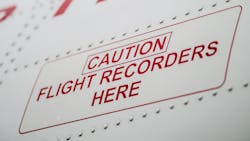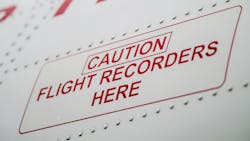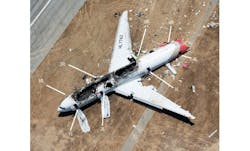Are black boxes obsolete?
Black box history
In the 1940’s, early prototypes of the black box were introduced into airplanes as a result of militaries wanting better capture of flight test data, and commercial airliners wanting better clues as to what caused an aircraft to crash. The demand to design and use black boxes continued over the next decade. One of the driving forces was a series of fatal crashes that involved the de Havilland Comet which grounded the entire fleet.
Without any witnesses or survivors, determining the cause of these crashes was near impossible. This led to a report published by Australia’s Aeronautical Research Laboratory recommending that critical flight data be recorded and an initial prototype built.
Following the investigation of the 1960 crash of Trans Australia Airlines Flight 538, an inquiry judge recommended that flight recorders be installed in all airliners, propelling Australia to become the first country make cockpit-voice recording compulsory. During the remainder of the 1960s, laws were passed in most other countries, and by the end of the decade most airliners had flight data recorders installed in their fleets.
Black boxes have been the foundation of safety analyses for over 50 years, but do we need a more modern, more timely, and more accurate way to understand airline safety issues?
Additional communication and monitoring equipment
A wide range of communication devices are utilized on today’s airliners. Human voice/radio transmissions, flight data recorders, cockpit voice recorders, altitude-encoding transponders, satellite-based global positioning systems (GPS), automatic dependent surveillance-broadcast (ADS-B), Aircraft Communications Addressing and Reporting System (ACARS), satellite communications (SATCOM), and now even 4G LTE cellular communications systems are now available.
Before the last decade most of these systems were put on board to increase safety and situational awareness. But more recently broadband satellite and 4G LTE systems were driven primarily for passenger entertainment, and then took advantage of the additional bandwidth to increase flight quality and efficiency.
Real-time engine monitoring and communication
Jet engine manufacturers and large subsystems suppliers are leading the industry in this real-time monitoring space, and many have already deployed systems onboard commercial airliners. These systems collect real-time data generated by the aircraft systems on board (or on-premise) and then remotely (off-premise, typically a cloud/data center) combine this operational data with historical and real-time data from other systems, and perform data analytics on this massive database to drive a transformation of this data into immediate business intelligence. This connected system of integrating real-time sensors information with other data is now commonly known as the Internet-of-Things (IoT).
This IoT intelligence can reveal trend and fault patterns on specific aircraft systems, classes of aircraft systems, or entire fleets of aircraft that can drive immediate actions for optimizing operations, or queue up parts and maintenance and repair operations (MRO) teams that can drive higher levels of aircraft availability. This reduces operational interruptions, increases serviceability, and has the potential to reduce major performance and maintenance issues. Everyone wins – airlines obtain greater operational performance, with higher fuel efficiency, and aircraft systems manufacturers gain valuable insight for creating even more powerful and reliable systems for future insertion.
The collection and integration of this data is fully autonomous, driving higher sampling IoT sampling rates for the entire industry. Analysis of this data is a service that is delivered as scaled business model, from very low-cost to more comprehensive levels that drive fleet-specific intelligence, optimization and management.
Here is a sample of the intelligence derived from combining historical performance data with real-time data to transform and improve operations for airlines:
- Optimized fuel management for decreasing the amount of fuel consumed
- Optimized flight paths using performance-based Navigation (PBN) services for reducing flight track miles, which in turn, reduces fuel and emissions, and enables flight paths to reduce noise reduction
- Optimized airport traffic flow / sequence management for better fleet synchronization, and reduction of hold times on the ground
- Flight analytics to enable optimized MRO activities
IoT systems intelligence to create higher safety and security
With today’s IoT systems and the wide range of capabilities to communicate the status of an aircraft (FDR, CVR, Human voice/radio, transponders, GPS, ACARS, ADS-B, SATCOM and 4G LTE – it is hard to understand why we do not know why an aircraft is lost until recovery of the black box from a wreckage. The tragic losses of Air France Flight 447 (AF447) and Malaysian Airlines Flight 370 (MH370) demonstrate the need for a better way to immediately capture real-time flight data as systems begin to degrade, and certainly well before there is a loss of an aircraft.
Black boxes are only valuable after a crash and only if the aircraft can be found, and only if it is found in a timely manner. Many black boxes from aircraft that have crashed are in locations that are nearly impossible to locate and retrieve. Black boxes in crashes as such United #389 (1965), Pan Am #816 (1973), and Eastern Airlines #980 (1985) have never been recovered.
Radio communications are only valuable if humans communicate with perfect diction and timing. GPS is great for location data, but still needs additional information, beyond that required by ADS-B, to be truly a supplier of real-time business intelligence and situational awareness. SATCOM and 4G LTE provide great bandwidth but many airlines do not have this capability, and even fewer use broadband capabilities to relay system sensor and platform information for immediate analysis to optimize flight safety and operational performance.
We need to increase the situational awareness of all passenger aircraft using the proven IoT business model of collecting/analyzing real-time data from a wide range of sensors and using this intelligence to perform predictive analytics not only to improve flight performance, but also increase the security and safety of flight to the point where it can prevent the loss of an aircraft. In the most extreme case we will at least be able to know why an aircraft was lost, and to immediately be able to begin to correct any issues in airline fleets well in advance of finding the black box from a crash. Retrieving black boxes simply does not reflect the vast information resources we have available in airline systems today. Storing all vital information on a vehicle is simply not smart – we need to augment storage of on-board, on-premise critical flight data with storage remotely, off-premise, where it can be retrieved in seconds.
This is not new technology – the technology behind a highly responsive, intelligent transportation system exists today – we simply are slow to adopt it. In the past it was always financially prudent for airlines to slow the insertion of new safety equipment – it is extra cost that provides little value in day-to-day operations, and only has value when there is a rare loss of an aircraft. IoT systems are different – the benefits associated with the investment are realized on the first flight, and, as the business intelligence grows, the benefits increase with every flight.
Today, we have immediate access to real-time data from many aircraft sensors that can be instantaneously available on a global scale. These sensing systems are already built into most modern avionics platforms, from flight decks to common core computers to jet engines. ACARS systems were designed to limit transmissions of flight data to conserve bandwidth that was scares in the past, but today broadband networks are now widely available. This new airborne broadband capacity enables us to design systems that have deep situational awareness as its foundation. At a minimum we need to stream both ACARS data and ACAU/black box data to off-board systems using this new broadband capacity.
This buildout of broadband capabilities was not done by government mandate or safety imperative or for better control of operations – it was driven (and subsidized) by passengers wanting higher levels of connectivity in flight. These passengers would gladly support a degradation of bandwidth if the onboard systems needed to send greater amounts of data when flight systems fail and needed to commandeer more communications capacity. Most existing airborne IoT systems were originally inserted into aircraft for fuel systems and flight path optimization – with this new, expanded flight paradigm these IoT sensors and analyses can also augment our safety and security of flight.
Using IoT data for augmenting aircraft safety is creating business intelligence that simply cannot be done by pilots, ground crews, or standalone sensing systems. Human-in-the-loop systems are simply too slow to understand and too slow to respond to sensor inputs defining degrading systems. Autonomous, real-time sensor fusion is the backbone of this IoT revolution, and the immediate analysis resulting in actionable directions will deliver higher levels of quality, safety, security, serviceability and operational excellence with each flight. This global, intelligently connected network of aircraft IoT systems will enrich the entire aerospace industry, and has the potential to save lives by preempting losses of aircraft where acquired intelligence can correct failures in flight.
Conclusion
Are black boxes obsolete? No, but today’s IoT business transformation is a real opportunity to improve airline safety and security without significant investment, and without adding size, weight, and power (SWaP) to today’s airline fleets. Analyzing real-time IoT data in flight allows us to optimize a wide range of positive business attributes using existing technology, assets, and infrastructure. We can move beyond the singular, static black box environment into a new era of connected knowledge, leveraging ground-based systems to improve situational awareness for both pilots and crew. We can increase safety, survivability, and operational performance without significant new investment, by simply changing the way we observe, manage, and analyze our airborne environments.
To learn more about Wind River aerospace and defense solutions, visit http://windriver.com/solutions/aerospace-defense/. For more information about how Wind River is addressing the opportunities and challenges created by the IoT, visit http://windriver.com/iot/#!/iot/.
Chip Downing is a senior director of business development for aerospace and defense at Wind River. He is a 20-year veteran of the embedded systems industry and a pioneer in safety certification for commercial real-time operating systems.
Flight recorder and MH370 images courtesy Shutterstock.




